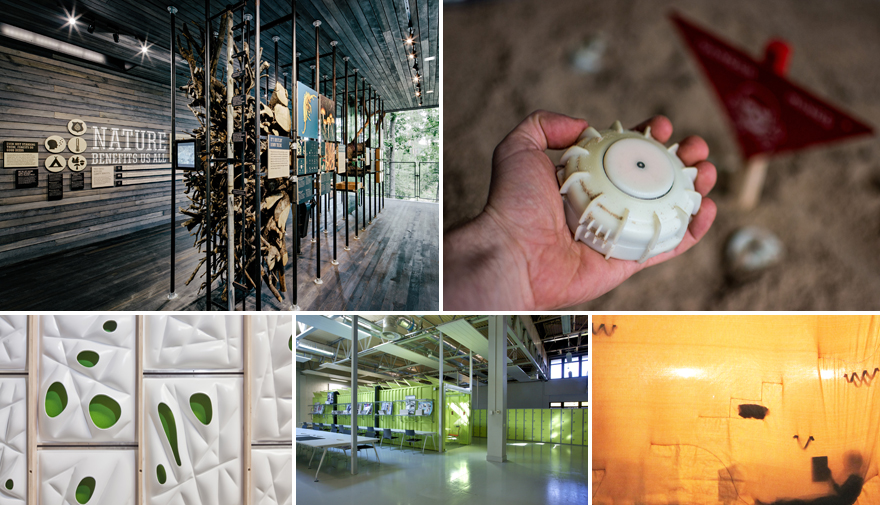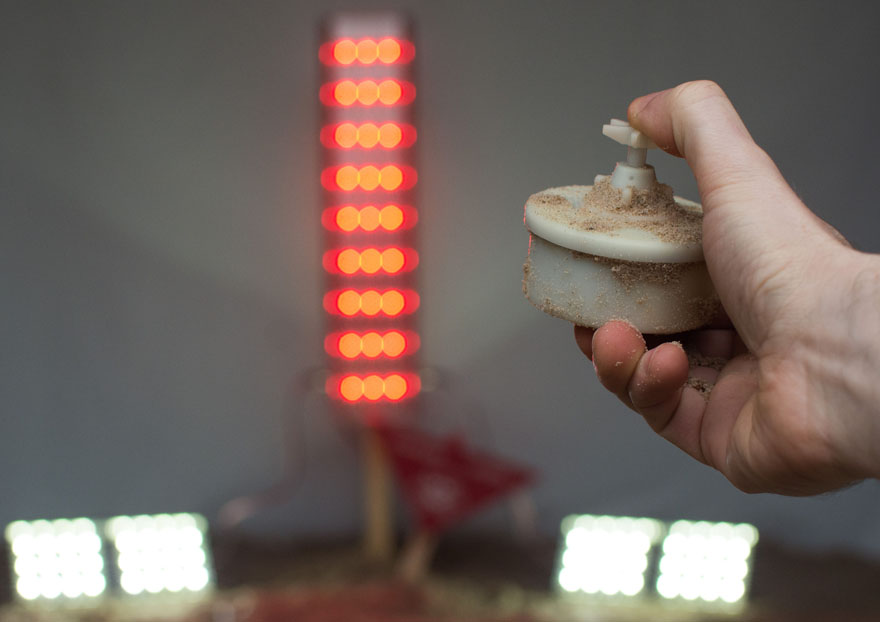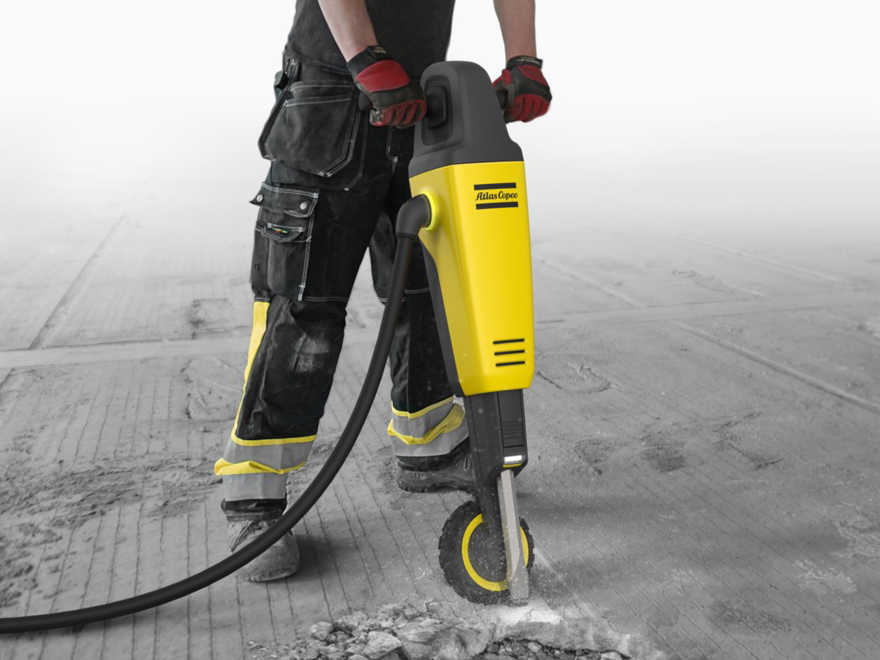

From permanent installations to temporary structures, perhaps no area of design reflects our current cultural disposition more than the deesign of space itself. This year's submissions for the Interiors & Exhibitions category of the 2014 Core77 Design Awards did a fantastic job of reminding us of the many ways it can be interpreted. The jury team, led by Geoff Manaugh, recognized a dozen entries this year, from thought-provoking student concepts to impactful improvements to extant spaces.

Professional Winner: Sustainability Treehouse, by Volume Inc. and Studio Terpeluk
Volume Inc. and Studio Terpeluk teamed up to bring sustainability to an organization known for its commitment to tradition. Not only does their Sustainability Treehouse for the Boy Scouts of America place visitors in a sustainable environment, it also tells a story through important facts and suggestions. "While the project risks falling into kitsch or even cliché, it nonetheless manages to be an imaginative and highly inspiring sequence of spaces for just the right age of user, the young Scouts who are its intended audience," says Jury Captain Geoff Manaugh. "The Treehouse also brings a message of sustainability—of personal responsibility, recognition of one's own environmental limits and respect for the needs of others, both now and in the future—to an organization that might normally skip that message in favor of the Boy Scouts' traditional focus on masculine self-determination. That makes this an important yet playful space, and one that's beautifully designed both architecturally and graphically."
» Learn more about Sustainability Treehouse

Student Winner: Blastproof: A Hands-on Exhibition about Humanitarian Mine Removal, by Chris Natt
Landmines are but a vicarious news item (or metaphor) for most of us, but they are a daily reality for residents of war-torn nations. Royal College of Art student Chris Natt brings us an interactive look into the daily lives of the people responsible for removing the weapons from conflict-affected areas. Throughout the exhibit, visitors can interact with electronic replicas of the devices and experience the visuals that go hand-in-hand with the explosives. "Fascinating R&D with a critical subtext: Reactive training tools that enhance the perception of mine hazards," says juror Hayley Eber. "The museum-based detonation triggers a range of auditory, visual and tactile stimuli to communicate the event. It would be great if the installation could find a permanent home, and the prototypes went beyond 3D printing." Fellow juror Jake Barton appreciates the attention to the sensitive material: "It's really, really hard to make something that horrific be both experiential, impactful, and also respectful. I think it's the right mix and a great achievement."
» Learn more about Blastproof: A Hands-on Exhibition about Humanitarian Mine Removal

Professional Runner Up: Breaking the Mold—VarVac Wall, by HouMinn Practice
It goes unsaid that an architecture school has to be housed within a memorable structure. The University of Minnesota School of Architecture looked to HouMinn Practice to give them a front office worthy of a a few photo ops. The VarVac Wall works specifically with sound—some sections of the wall absorb it while others reflect noise. The ultra-textured surface is made of vacuum-formed panels that are either solid or perforated, depending on their function. "This strikingly realized tweaking of a relatively common manufacturing process shows at least one way for new architectural designs to be realized in the tooling and fabrication stage, where aesthetic results—and these wall panels are definitely gorgeous—emerge less from a designer's own palate and more from the materials themselves," says Manaugh. "On a technical level, as well, this system points toward intriguing future overlaps between the realization of architectural systems and the production of industrial products."
» Learn more about Breaking the Mold—VarVac Wall

Professional Runner Up: Architecture Factory, by Marc O Riain (CIT) and Neil Tobin (RKD)
We live in a time where shipping containers are finding more applications—or at least more media exposure—as trendy space solutions beyond the shipping industry. Marc O'Riain of the Cork Institute of Technology (CIC) and Neil Tobin of RKD Architects have incorporated a series of containers into an open office space plan. Architecture Factory turns the CIC's Department of Architecture into a collaborative space despite the claustrophobic size constraints of a single shipping container. Jurors Yen Ha and Michi Yanagishita appreciated this contrast: "The project presents a different approach to shipping containers by using them not just as containers, but as walls and dividers of space. A great project that defines space without creating barriers, providing visual interest and continuity."
» Learn more about Architecture Factory

Student Runner Up: Cocoon, by Tanya Shukstelinsky
Our living spaces are becoming smaller, but at least our floorplans are keeping up with the trend and more creative ways to embrace (and use every inch of) the space we have are popping up. You won't want to make a permanent home out of Bezalel Academy of Arts and Design student Tanya Shukstelinsky's Cocoon, but it is an intriguing look at the way our public spaces define our personal territories. The structure is made of textiles sewn together to create stairs, sleeping areas and other living areas. The jury team had a few situational suggestions for this design: "the implications for things like tent design or portable camping shelters—let alone children's play rooms—are fascinating to consider," says Manaugh. Ha and Yanagishita had another idea: "Cocoon reduces the idea of what it means to be in a space to the bare minimum. Definitely the new hammock for start up tech offices."


 Ask your doctor if Silk Leaf is right for you
Ask your doctor if Silk Leaf is right for you












 Tartan samples from Kinloch Anderson
Tartan samples from Kinloch Anderson



































